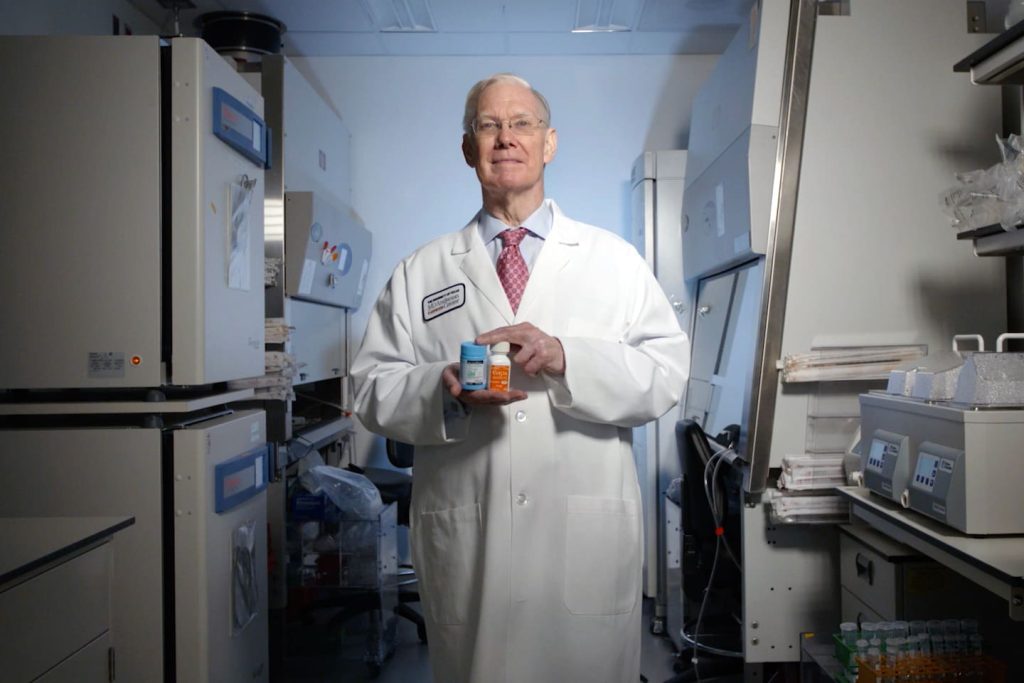His Death Announced Jordan was a professor at the University of Texas MD Anderson Cancer Center in Houston and had been suffering from kidney cancer, according to his daughter, Alexandra Noel.
Dr. Jordan, who grew up in the UK and has dual British and American citizenship, was once told the interviewer He had poor grades and “barely graduated from elementary school.”
But his early report cards did not reflect the curiosity, tenacity, and talent that would eventually make him one of the most important cancer researchers of the second half of the 20th century and known as the “father of tamoxifen.”
When Dr. Jordan began his research as a doctoral student at the University of Leeds in the UK in the late 1960s, cancers that were considered treatable were treated in three main ways: surgery to remove tumours, and radiation and chemotherapy to kill cancer cells.
Historically, patients with breast cancer have undergone radical and often disfiguring surgery to remove the breast and surrounding tissue.
Radiation therapy opened new avenues of treatment but came with serious side effects, and the most recent advance in tumor treatment – chemotherapy – has revolutionized medicine but is often harsh on patients.
“I was obsessed with the idea. [that] Combination chemotherapy will cure all cancers,” Dr. Jordan said. told the website Oncology Central 2019.
“It was like we were trying to turn the tide,” he added. He and his colleagues were trying to encourage scientists to look beyond chemotherapy regimens, which attack the body relatively indiscriminately, and consider the possibility of drugs that target specific cancer cells.
Dr. Jordan demonstrated the potential of his idea in an unexpected way with tamoxifen, an anti-estrogen drug that began life as an experimental contraceptive.
Tamoxifen as a contraceptive worked brilliantly in rats, but failed spectacularly in women: “Women who took it almost always conceived a baby,” Dr. Jordan said.
“During the sexual revolution of the 1960s, the last thing anyone wanted was to get pregnant,” he told the Chicago Tribune in 1998.
But Dr. Jordan saw another use for tamoxifen and investigated it further: For years, it had been known that women with a certain type of breast cancer – those with estrogen receptors – responded well to removal of the ovaries, which produce estrogen.
Dr. Jordan speculated that anti-estrogen drugs might have a similar beneficial effect, and in 1973 he demonstrated that tamoxifen could prevent breast cancer in rats.
By the following year, human trials had begun in the United States, and in 1977 the Food and Drug Administration approved tamoxifen for use in patients with advanced breast cancer.
Over the next decade, tamoxifen was approved to treat early-stage cancer in combination with surgery, and in 1998, the FDA approved it for use in high-risk but still healthy patients to prevent the disease from developing.
After Dr. Jordan’s death, the Cancer Prevention Foundation credited him with discovering “the first FDA-approved drug for cancer prevention.”
Tamoxifen does have risks, including the risk of uterine cancer and blood clots in some cases. However, it is one of the most commonly prescribed drugs for cancer treatment and is recommended by the World Health Organization. List of essential medicines.
Tamoxifen is known as a selective estrogen receptor modulator (SERM). Other SERMs include raloxifene, another of Dr. Jordan’s research interests, which is used to prevent osteoporosis as well as breast cancer.
Dr. Jordan was born Virgil Craig Johnson in New Braunfels, Texas, on July 25, 1947. His British mother and biological father, a Dallas native, met during World War II while his father was serving in the U.S. Army in England.
The couple moved to Texas after the war, but divorced when Craig (who was called Dr. Jordan) was still a toddler. He and his mother moved to England, where he grew up in Bramhall, near Manchester, and was raised by his mother and stepfather, who adopted him and gave him the surname Jordan.
Despite his poor academic performance, Dr. Jordan was interested in chemistry from an early age.
“I turned my bedroom into a chemistry lab, but not one of those kids’ kits you get from the pharmacy or bring home from school; it was a real chemistry lab,” he says. I remembered it a few years later.
“There were a lot of times where our experiments would explode or catch fire and our lives would be in danger. We’d have to throw things out the window,” he continued. “But my mother would always say, ‘At least we know where he is.'”
He eventually enrolled at the University of Leeds, where he obtained a BSc in pharmacology in 1969 and a PhD in 1973, with a dissertation on tamoxifen. The university awarded him a Doctor of Science in 1985.
Dr Jordan joined the Royal Army Officer Training Corps whilst studying at Leeds University and subsequently served in the Intelligence Corps, the Special Air Service and in the Reserves for many years.
During his scientific career, he worked at institutions including the University of Wisconsin-Madison, Northwestern University in Evanston, Illinois, Fox Chase Cancer Center in Philadelphia and Lombardi Comprehensive Cancer Center at Georgetown University Hospital before joining MD Anderson Cancer Center in 2014.
Dr. Jordan was married to Marion Williams, Monica Morrow and Julia Yauch, all of which ended in divorce. He is survived by two daughters from his first marriage, Alexandra Noel of Stillwater, Minnesota, and Helen Turner of Salt Lake City, Minnesota, as well as five grandchildren.
As he became known as the “father” of the life-saving breast cancer drug, Dr. Jordan told the Houston Chronicle that he frequently encountered people who said, “My mom takes tamoxifen. My wife takes tamoxifen.”
“Mothers have seen their children grow up.” He said“Grandmas have watched their grandchildren grow up.”


